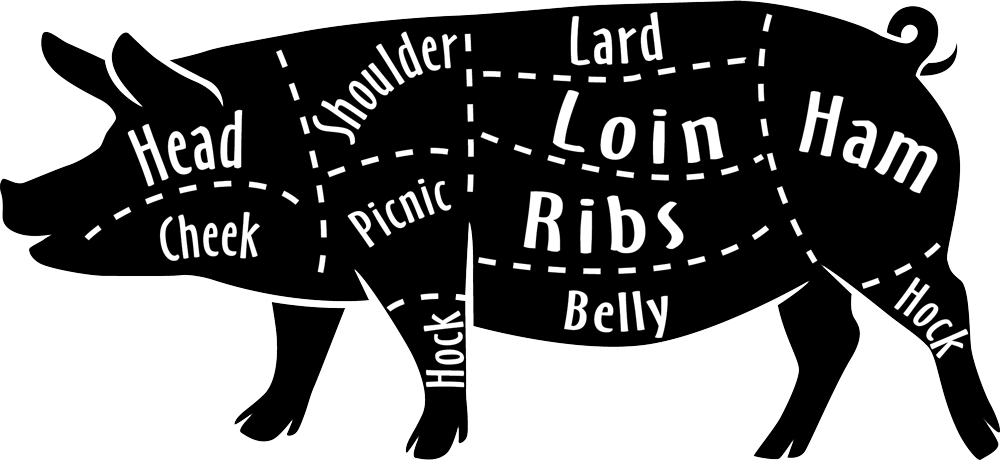Pork is the culinary name for the meat of a domestic pig. It is the most commonly consumed meat worldwide, with evidence of pig husbandry dating back to 5000 BC. Pork is eaten both freshly cooked and preserved. Curing extends the shelf life of the pork products and makes them even more delicious!
Prosciutto anyone?

Pork Head
Pig’s head is most commonly cooked to make brawn, stocks and soups. For all these desired outcomes, boiling is obviously recommended. Brawn, if you don’t already know, is a cold cut of pork that is sourced from pig’s head and crafted into a terrine or meat jelly.
Pork Jowl
The Cheek muscle. Different food traditions have this as either a fresh or cured product.
Pork Shoulder
Unlike the more lean tenderloin and chops, pork shoulder is an incredibly forgiving cut of meat. It becomes more tender as it cooks and benefits from a lengthy cook time.
Don’t worry about keeping this cut on the heat a few minutes too long, you won’t suddenly end up with something dry or rubbery.
Pork Butt
This cut comes from the upper part of the shoulder from the front leg. The blade bone can be left in this cut.
Consider pork butt for all your pulled pork needs!
Pork Picnic
Picnic shoulder, is the shoulder of the pig with a bone remaining in it. Since the “shoulder” of a pig is a leg and pigs walk on all four legs, the picnic shoulder is a cut with muscles that get a lot of work.
Pork Hock
A ham hock is the joint between the tibia/fibula and the metatarsals of the foot of a pig, where the foot was attached to the hog’s leg. It is the portion of the leg that is neither part of the ham proper nor the ankle or foot (trotter), but rather the extreme shank end of the leg bone.
Pork hock is a very inexpensive and tough piece of meat that is loaded with connective tissue, ligaments and muscle fibers. When cooked low and slow, however, it yields fork-tender meat and a very flavorful broth that is useful for making stews and soups.
Pork hocks are available either smoked or unsmoked.
Pork Lard
Lard is a semi-solid white fat product obtained by rendering the fatty tissue of the pig.
If you haven’t cooked with lard, you don’t know what you’re missing! It’s incredibly stable at high heat making it the ideal oil to sear your steaks or fry your eggs in!
Pork Chop
A pork chop is a loin cut taken perpendicular to the spine. They can contain a rib (rib end) or part of a vertebra (center cut), or be boneless. Chops are usually served as an individual portion.
Pork Loin
Pork Loin is a wide and thicker cut with a fat layer on top, not to be mistaken for the tenderloin, which is long and thin. This cut comes from the tissues along the dorsal side of the rib cage.
Pork Tenderloin
This cut is a long thin tender piece. It refers to the psoas muscle along the central spine portion. It’s the most tender cut of pork you’re going to get.
But be careful, because there’s so little fat, it’s very easy to overcook this cut!
Pork Ribs
Back Ribs: More commonly known as baby back ribs are taken from the top of the ribcage between the spring and spare ribs. These are usually meatier than the spare ribs.
Spare Ribs: These are cut from the lower portion of the pig, the belly and breastbone, behind the shoulder and include 11-13 long bones. There is a covering of meat on top and between the bones.
Pork Belly
Pork belly starts out from the underside or the belly of the pig. But don’t think of the word “belly” as in stomach, rather it’s the flesh that runs on the underside of the pig.
Pork belly is uncured, un-smoked and unsliced bacon. Meaning it has all the potential to become something absolutely incredible!
Pork Ham
Ham is pork from a leg cut that has been preserved by wet or dry curing, with or without smoking.
As a processed meat, the term “ham” includes both whole cuts of meat and ones that have been mechanically formed – Know the difference!!
At Big Bend Market, we only use whole cuts of meat for our ham.
Pork Feet
A pigs trotter, known as the foot. The cuts are used for various dishes around the world.
Have Questions? Call Us or Visit Our Facebook!